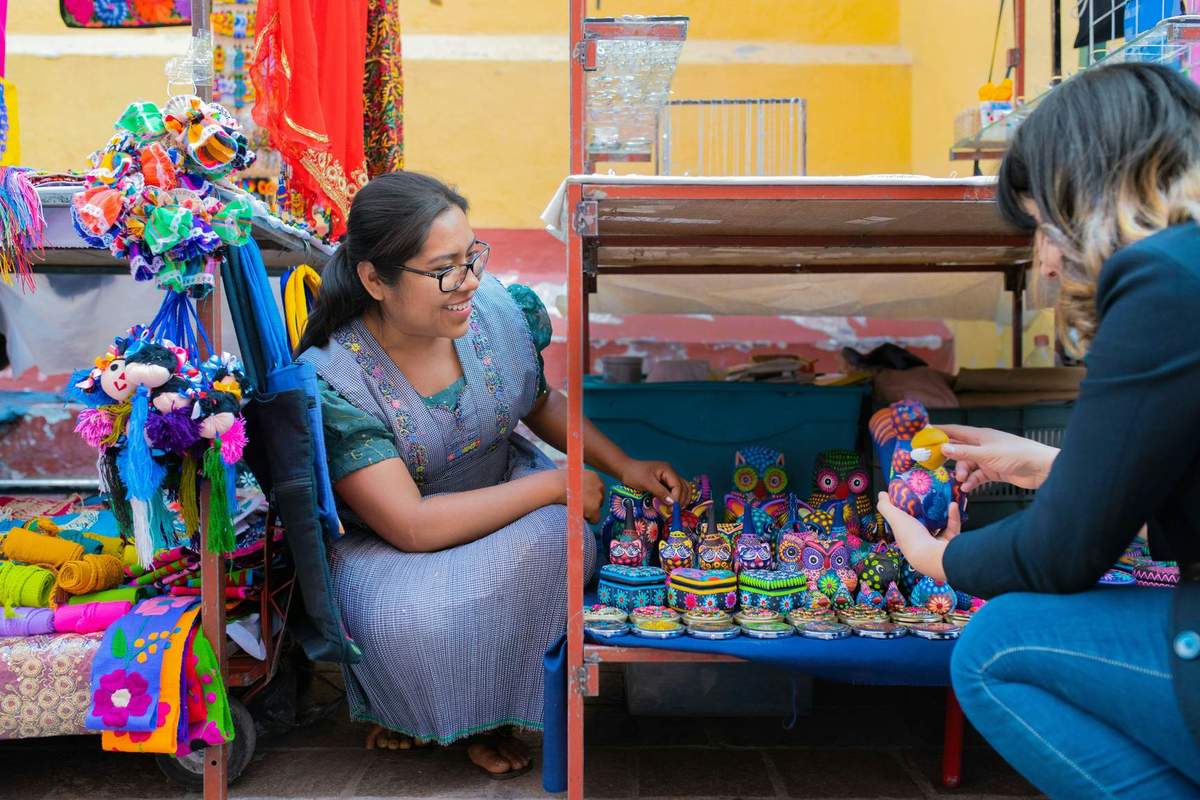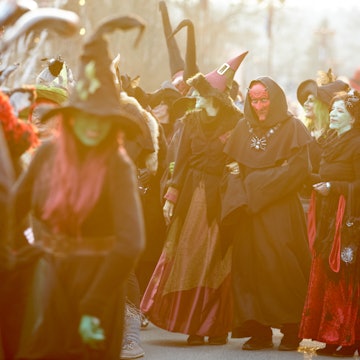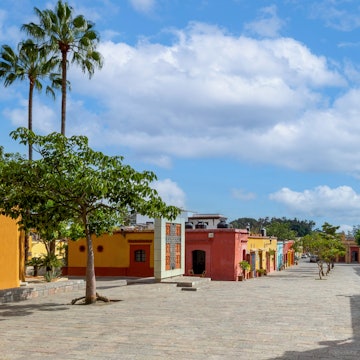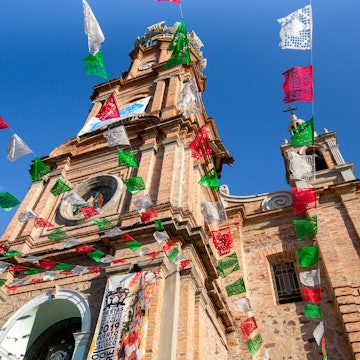

The epic Guelaguetza festival every July is one of Oaxaca’s most exciting annual traditions. Diana G Pina/Shutterstock
Thanks to its cultural, historical and culinary richness, Oaxaca is a destination that captivates a wide range of travelers — history buffs, art and architecture enthusiasts, and, of course, mezcal and food aficionados.
Whether you're eager to immerse yourself in its vibrant markets or indulge in the exceptional cuisine of its restaurants, the city invites you to explore it slowly, consciously and on foot.
By walking, discover how colonial architecture blends with cobblestone streets and charming squares, witness how the mountains frame ancient churches, realize that short rides can lead to magical towns, and how, just three hours away, you can now access some of the most iconic beaches of the Mexican Pacific.
Get lost in quesillo, chocolate, tlayudas and authentic mezcal while checking off the top things to do in Oaxaca.
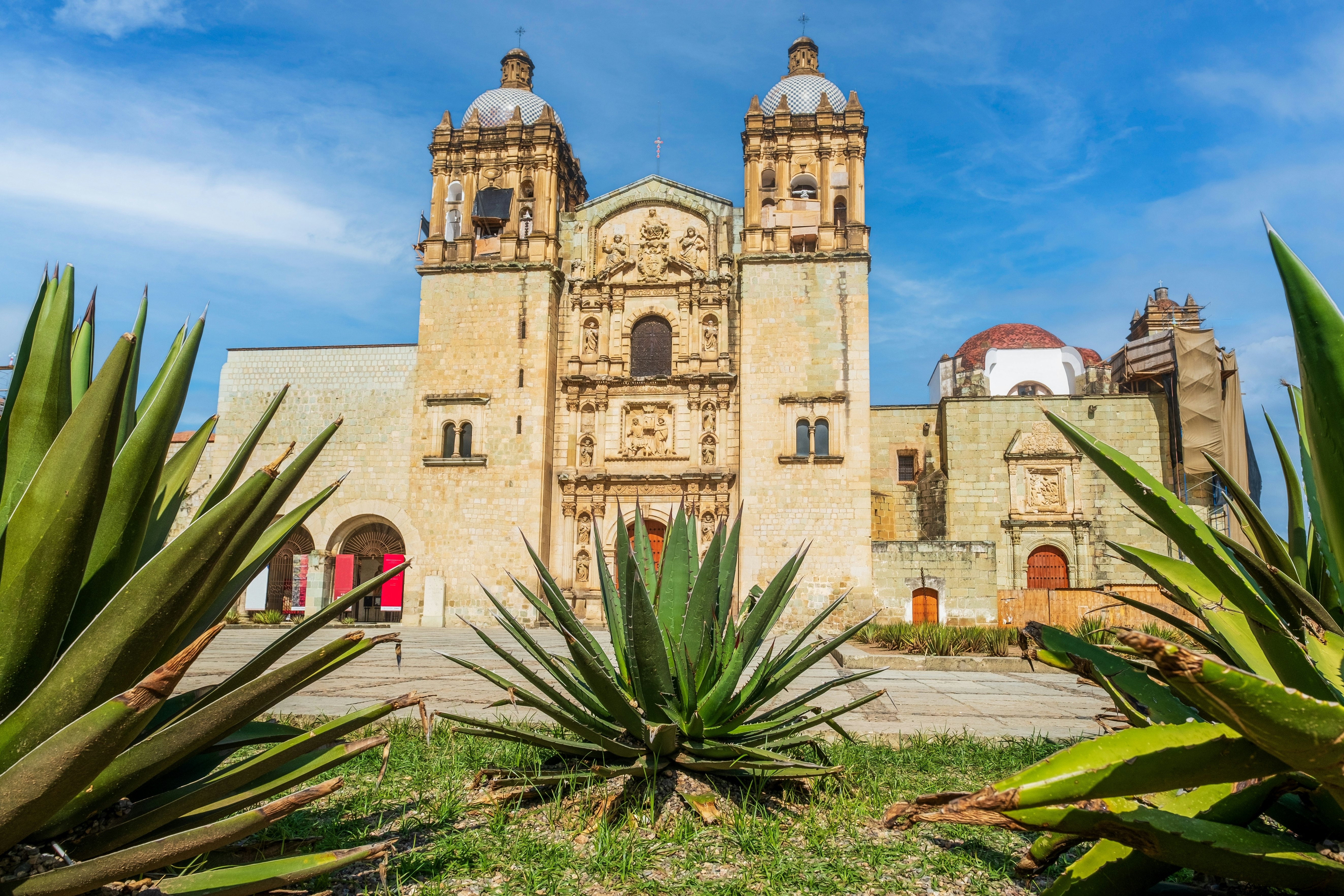
1. Marvel at Santo Domingo
In my opinion as a travel journalist who has explored countless churches across Mexico, Santo Domingo is enough of a reason to travel to Oaxaca.
As one of the most beautiful churches in Mexico, this one is not only the center of the city but also a place of gathering, for important celebrations such as weddings, a common ending point for the famous calendas (a traditional Oaxacan parade that blends music, dance, fireworks and colorful processions and concludes at the church or temple that houses the honored saint or Virgin), and home of the most beautiful botanical garden.
Templo de Santo Domingo de Guzmán is one of the finest examples of Mexican Baroque architecture.
Declared a historical monument in 1933, its richly decorated interior features an impressive genealogical tree of Saint Dominic, medallions depicting Dominican martyrs and beautifully restored altarpieces.
This hidden gem invites visitors to connect with Oaxaca’s native flora, serves as the backdrop for countless weddings and even telenovelas like Mi marido tiene familia, but above all, it’s simply a beautiful and peaceful place.
Local tip: The Jardín Etnobotánico de Oaxaca is open year-round and can only be visited through guided tours, which are offered in both Spanish and English. Tours last between one and two hours.
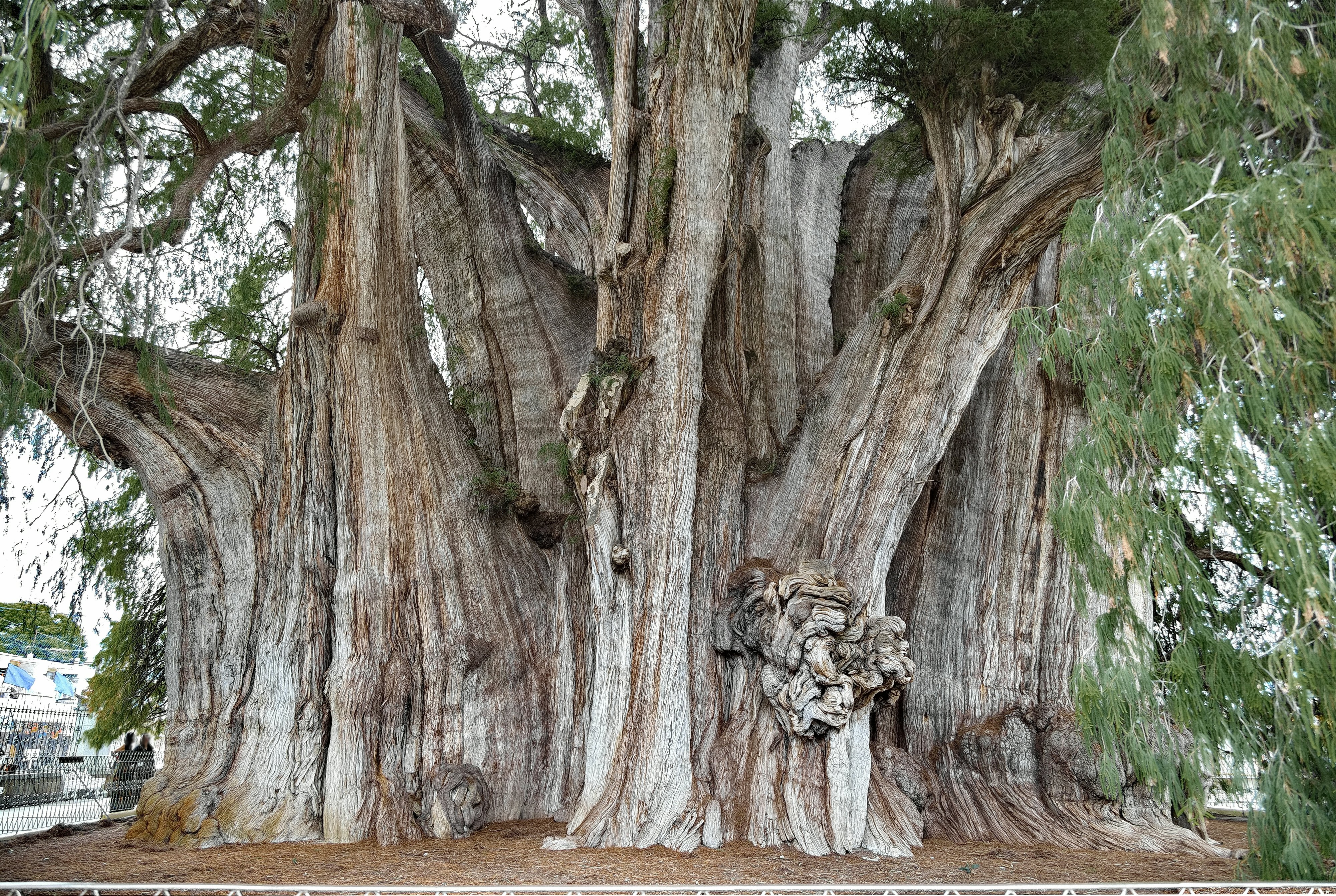
2. Discover a magical tree
Speaking of nature, just 20 minutes from Oaxaca lies the town of Santa María del Tule, home to one of Mexico’s most extraordinary natural wonders — El Árbol del Tule.
This majestic ahuehuete tree is believed to be over 2000 years old and holds the record for the widest trunk in the world.
Towering at 138ft tall (42m) and weighing around 636 tons, it’s not only one of the oldest living beings on the planet, but also one of the heaviest.
According to Zapotec legend, the tree was planted by a priest named Pechocha, a devotee of the wind god Ehécatl, as an offering. Over the centuries, it has become a symbol of life, resilience and reverence for nature.
Although the town square is always open to visitors, access to the tree’s immediate area is available daily from 8am to 8pm for a modest fee.
Local tip: Locals claim you can spot fantastical figures in its textured trunk with shapes resembling an elephant, a lion’s head, a deer, a fish and even the Three Wise Men. These whimsical details are often pointed out by local children who act as informal guides.
3. Eat like a local, marvel like a foreigner
One of the best things about Oaxaca is that you can enjoy a delicious tlayuda (crispy, thin tortilla) at a little stand in the famous Mercado 20 de Noviembre and later savor an elaborate meal at one of the Michelin-acclaimed restaurants.
While in the market, you must try quesillo (one of the best cheeses you’ll ever have), tlayudas con asiento (a layer of pork fat) or tasajo (thinly sliced beef). You can also be adventurous and sample chapulines (crickets).
Head to the famous Pasillo de Humo (inside the Mercado 20 de Noviembre), where the air is thick with the mouthwatering aroma of freshly grilled meats.
This vibrant corridor, run by dozens of Oaxacan families, offers everything from cecina enchilada and chorizo oaxaqueño to longaniza, ribs and even tripas and ubre de res (beef tripe and udder), all cooked over open charcoal grills and served with homemade salsas.
If you're looking for a more traditional breakfast, try Boulenc or Pan con Madre, both with delicious pastries and coffee. Another worthy coffee spot is Café Café.
At Tierra del Sol, a Bib Gourmand–recommended restaurant by Michelin and just steps from Oaxaca’s iconic Santo Domingo church, Chef Olga Cabrera honors her Mixtec heritage (Ñuu Savi, or "people of the clouds") with recipes rooted in ancestral knowledge.
More than just a restaurant, her space is a celebration of tradition; home to a bakery that fills the air with sweet aromas, an atolería and a rooftop restaurant where tortillas are handmade on the comal.
For all popular restaurants, reservations are highly recommended.
Local tip: If you'd like to dive into the secrets of Oaxacan cuisine, consider taking a cooking class with a traditional cook like Carina.
4. Immerse in mezcal culture
Of course, Oaxaca is the birthplace of mezcal, and while you can enjoy this iconic spirit in renowned bars and mezcalerías like In Situ, Los Amantes, Mezcalogía and Sabina Sabe, the most meaningful way to understand this drink is to follow the Mezcal Route itself.
Just 20 minutes from the city you can get to Santiago Matatlán, known as the Mezcal World Capital, where over 40% of the world’s mezcal is produced.
There, you can visit palenques: small, family-run distilleries that specialize in different agave varieties: Arroqueño, Cerrudo, Espadín, Madrecuixe, Tepextate or Tobalá, each with its own taste, texture and color.
The maestros mezcaleros (master distillers who’ve passed down the craft for generations and oversee everything from harvesting wild agave to cooking and fermenting) may offer you a taste of mezcal de pechuga, a triple-distilled spirit infused with chicken breast or with seasonal fruits, known for its smooth, aromatic character.
Tours like Mezcal Educational Tours will allow you to learn how mezcal is made — from roasting the agave to distillation in copper or clay stills — but also to purchase small-batch bottles not yet available to the public.
Keep in mind that many of these do not have COMERCAM certification (Consejo Regulador de la Calidad del Mezcal, Mexico’s regulatory council), which means you can enjoy them during your stay but they can’t be taken on a flight.
If you want to buy bottles to take home, head to Los Danzantes, a restaurant that not only offers premium mezcals but also a dining experience recently recognized with a Michelin Star and a Green Star for sustainability.
Local tip: Mezcals are classified as joven (young), reposado (aged 4–12 months in barrels), or añejo (aged 1–4 years). Over 5 years, it’s considered Gran Reserva.
5. Drink spirit-free
Beyond its vast mezcal tradition, Oaxaca is also known for its morning drinks, that includes atole, coffee, chocolate and tejate (a refreshing pre-Hispanic beverage made with maize, cacao, mamey pit and cacao flower).
Head to Atolería, where you’ll learn about atole, one of the most traditional Mexican breakfast drinks. It’s made with masa (corn dough) and typically flavored with ingredients like chocolate or strawberry.
Here, chef Olga (yes, the same from Tierra del Sol) uses seasonal ingredients such as coconut, guava, lavender, mamey, plum, soursop, tamarind and many more.
As for chocolate, a favorite is Mayordomo, a beloved Oaxacan brand founded in 1956 in Tlacolula and now a staple across local households.
You can enjoy a traditional Mexican breakfast (chilaquiles, enchiladas or divorciado eggs) paired with a rich, velvety cup of hot chocolate made from their signature blend of cacao, cinnamon, almonds and sugar.
Local tip: If you buy chocolate or coffee in properly sealed bags, you can bring them on your flight. If you buy loose grains or handmade chocolate at the market, better to enjoy it during your stay.
6. Learn, and shop, authentic artesanías
One thing that makes Oaxaca truly unique is the abundance and variety of artesanías (arts and crafts).
While you’ll find many shops and workshops in the city in markets or Calle Macedonio Alcala, one of the best ways to understand them and support local communities is visiting nearby artisan towns.
You can hire a guide or rent a car and plan your own route. Visit two towns per day to make the most of your time without rushing.
Local tip: Some handicrafts, like tapestries or ceramic vases, can be large. Many shops offer international shipping to Canada, the US and Europe — just ask in advance.
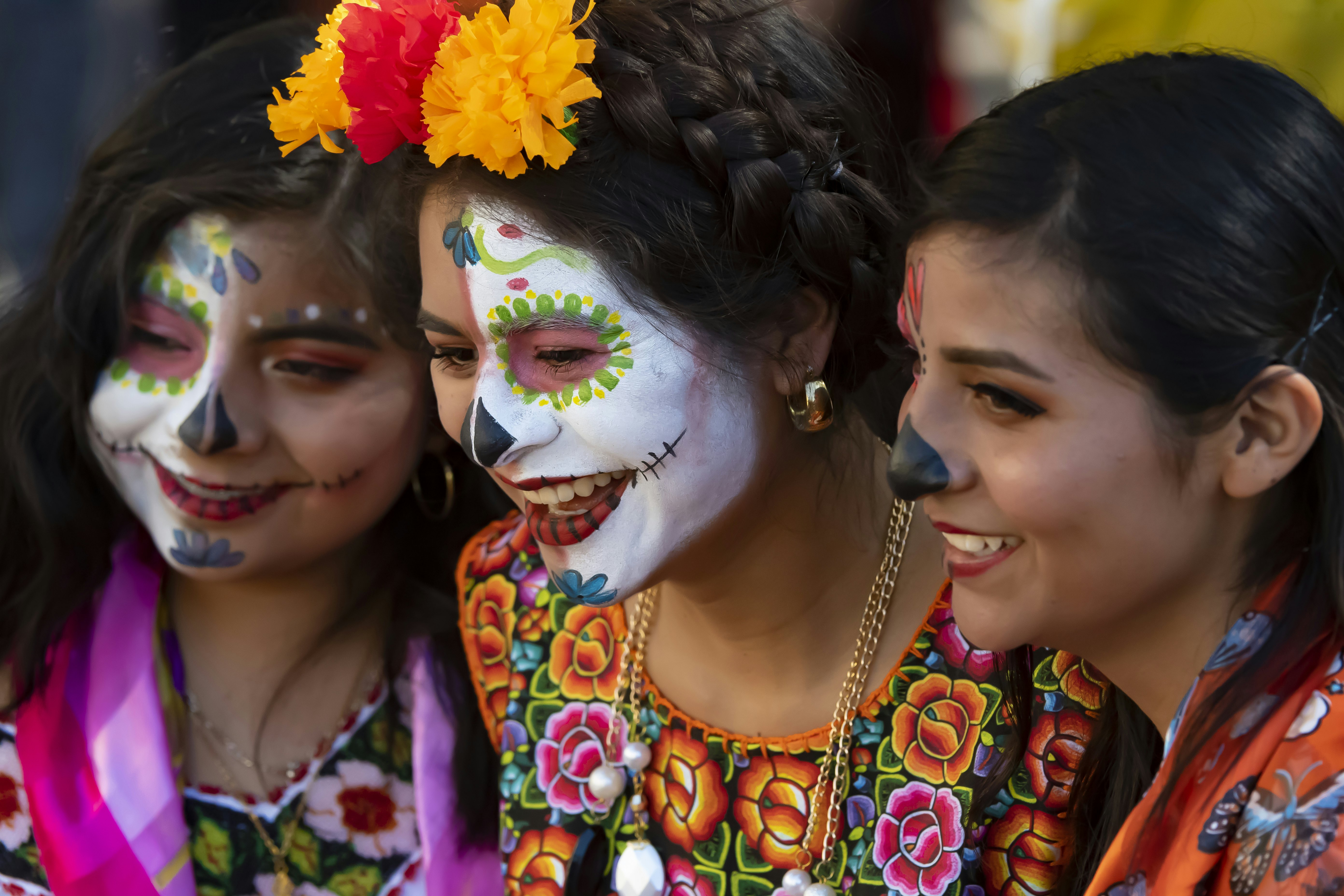
7. Experience Día de Muertos
Visiting Oaxaca during Día de Muertos (Day of the Dead) is like stepping into a vibrant dream woven with petals, candles, food and ancestral memory.
This sacred celebration transforms homes, cemeteries and entire neighborhoods into living altars filled with cempasúchil flowers, pan de yema, flickering candles and the scent of chocolate and mezcal.
Celebrated on November 1 and 2, the holiday honors the return of departed souls with altars adorned with offerings of their favorite foods and drinks, vibrant papel picado (delicately cut tissue paper featuring festive and symbolic motifs), family photographs and meaningful objects meant to guide their spiritual journey back home.
Each of Oaxaca’s eight regions celebrates in its own unique way, revealing the cultural richness and diversity of this tradition.
In Villa de Etla, locals celebrate La Muerteada, a lively nighttime procession where participants dress in costumes and masks to walk through the streets accompanied by brass bands.
In Zimatlán de Álvarez, people gather at dawn on November 1 to receive the souls of children, and on November 2, to welcome adults; both lovingly led back to their former homes.
One of the most heartfelt expressions takes place in Santa Cruz Xoxocotlán, just outside Oaxaca City. Here, the vela (vigil) begins on the night of October 31 and continues until sunrise on November 1.
Families gather in cemeteries to accompany the souls of their loved ones, adorning graves with marigolds, candles, pan de yema and clay and wire figurines made in Xoxocotlán.
Staying by the grave until dawn is not just an act of love, it’s a sacred responsibility, as it’s said that if the vigil isn’t kept, the spirits may grow sad and never return again.
Local tip: Don’t miss the monumental sand tapestries in Plaza de la Danza or walking through the artistically adorned neighborhood of Jalatlaco.

8. Unveil the magic of Hierve el Agua
One of the most iconic images from Oaxaca is undoubtedly Hierve el Agua, a breathtaking site nestled in the Sierra Mixe about 70km (43 miles) from the capital.
This natural wonder consists of white petrified waterfalls, more than 656ft (200m) tall, formed thousands of years ago by carbonated water rich in minerals like sulfur and calcium.
As the water drips over the edge of the cliff, it hardens into stone, creating the illusion of a cascading waterfall frozen in time. At the top, turquoise pools (fed by mineral springs) invite visitors to relax and soak in the view.
Hierve el Agua also holds deep cultural significance. Considered sacred by the Zapotec civilization, this was once an important ceremonial site, where water — life-giving and purifying — was venerated.
If you're planning to take a dip, keep in mind that the water is usually cold. Still, locals believe its mineral-rich composition offers healing benefits, from soothing skin conditions and easing indigestion to warding off negative energy.
Local tip: Access to the site is limited each day, so book a tour in advance. If you visit between June and August, the rainy season creates additional waterfalls that make the landscape even more magical.

9. Wander through the colors of La Guelaguetza
Every July, Oaxaca bursts into color, rhythm and flavor with La Guelaguetza, one of Mexico’s most vibrant and meaningful cultural celebrations.
Rooted in Zapotec traditions, the word guelaguetza means “offering” or “gift,” and that spirit of sharing lives on today through music, dance, food and ancestral ritual.
This extraordinary gathering brings together the eight regions of Oaxaca, each showcasing its unique heritage in dazzling performances filled with traditional costumes, brass bands and folkloric dances.
The sunset shows are especially breathtaking, often closing with fireworks that light up the Oaxaca sky.
Beyond the main shows, don’t miss the Desfile de Delegaciones, a joyful street parade through downtown Oaxaca. Or join a convite, an invitation from the Oaxacan people to join a lively procession that announces the beginning of festivities with mezcal toasts and regional snacks.
Local tip: Book early, as seats for the main events sell out fast and hotel occupancy soars during this season.
10. Make your stay an experience
One of other distinctive aspects of Oaxaca is that lodging here isn’t just about comfort, it could be part of your cultural immersion.
Several properties in the city offer not only beautiful spaces (and prime locations) but also meaningful experiences rooted in history, design and gastronomy.
Quinta Real Oaxaca once housed the convent of Santa Catalina de Siena. With more than four centuries of history behind its thick stone walls, this hotel (a UNESCO World Heritage Site) offers the chance to sleep surrounded by living history.
Just a short walk away in a restored colonial house is Escondido Oaxaca. This boutique hotel strikes a harmonious balance between heritage and modernity. Its architecture blends clean contemporary lines with historic textures.
At Otro Oaxaca, which faces the iconic Santo Domingo Church, the hotel’s understated façade opens into a series of open-air patios, a rooftop pool terrace and a cultural hub. Otro Bar offers some of the city’s best mezcal cocktails.

11. Step into the Sacred Mountain – Monte Albán
No trip to Oaxaca is complete without visiting Monte Albán, one of the most important archaeological sites in Mesoamerica and a window into the ancient Zapotec civilization.
Located just 5 miles/8km west of Oaxaca City (less than 20 minutes), this majestic complex rises atop a mountain in the heart of the Central Valleys.
At its peak, the city was home to nearly 35,000 people, most of whom lived on the terraced slopes of the mountain and worked in agriculture. Its connections with Teotihuacán during the Classic period are evident in its architecture, ceramics and mural paintings.
Today, Monte Albán is a UNESCO World Heritage Site. The protected area touches several municipalities, including Santa Cruz Xoxocotlán and San Pedro Ixtlahuaca.
To reach it, you can take the newer, paved “Dr. Ignacio Bernal” road, offering a direct route. Alternatively, the older, more winding carretera vieja (old road) leads from the road to Xoxocotlán, crossing the Porfirio Díaz bridge.
Regardless of the route, visiting Monte Albán is a profound journey through centuries of history, mysticism and ancestral wisdom.
Local tip: Some tours can take you to watch the sunset after hours, when the site is no longer open to the public.
12. Escape to the nearby beaches
For years, traveling between Oaxaca City and the coast meant more than eight hours on a winding, nausea-inducing road. I still remember being a teenager, riding along that route and feeling more dizzy than I ever had in my life.
Fortunately, the long-awaited new highway is now open, and it’s a game changer. You can now reach Puerto Escondido in about three hours by car. Puerto is a surfer’s paradise, but if you’re looking for something quieter head to Mazunte, a small beach town perfect for disconnecting.
Explore boutique hotels like La Valise Mazunte, a hidden gem with only six suites that integrates natural materials with the land, paying homage to the Oaxacan coast.
Experiences here blend with the surroundings: oceanfront massages, temazcal ceremonies, guided hikes, diving excursions (certifications like PADI are required), sunrise yoga, or — my favorite — sea turtle releases, which usually take place between July and December.






